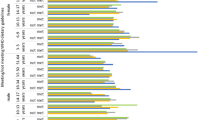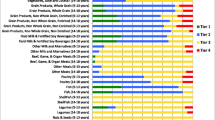Abstract
Aim
The consumption of ultra-processed food (UPF) and its impact on diet quality has been extensively studied and reported in the literature, but only a few studies have focused on children and adolescents. The present study therefore aimed to describe UPF consumption in a representative sample of French children and adolescents and to evaluate its association with diet quality.
Methods
The study included 1146 children and teenagers (3–17 years old) from the cross-sectional French Nutrition and Health Study 2006/2007 who completed three 24-hour food recalls over a period of 15 days. Food consumption was described using the NOVA classification. Regression models were used to estimate the association between UPF consumption and diet quality.
Results
The UPF dietary share in children and adolescents represented 44.2% and 44.5% of total energy intake respectively. In both age groups, UPF consumption was positively associated with dietary energy density and total carbohydrate and free sugars content, but negatively associated with dietary contents of protein, fiber, and potassium. UPF consumption also showed a positive association with inadequate intakes of energy density, free sugars, fiber, and potassium among children, and inadequate consumption of fiber and free sugars among teenagers.
Conclusion
Higher UPF consumption among French children and adolescents is associated with a lower quality diet.
Similar content being viewed by others
Data availability
Not applicable.
Code availability
Not applicable.
References
Abarca-Gómez L, Abdeen ZA, Hamid ZA, Abu-Rmeileh NM, Acosta-Cazares B, Acuin C, Adams RJ, Aekplakorn W, Afsana K, Aguilar-Salinas CA (2017) Worldwide trends in body-mass index, underweight, overweight, and obesity from 1975 to 2016: a pooled analysis of 2416 population-based measurement studies in 128.9 million children, adolescents, and adults. Lancet 390(10113):2627–2642
Birkhead GS, Riser MH, Mesler K, Tallon TC, Klein SJ (2006) Youth development is a public health approach. Introd J Public Health Manag Pract 2006;(Suppl):S1–S3
Browne MN, Kubasek N, Rex J, Horton R (2018) Commercializing children: laws and regulations affecting advertisements directed at children in France, Spain, and Sweden. Ind Int'l Comp L Rev 28:163
Cairns G, Angus K, Hastings G, Caraher M (2013) Systematic reviews of the evidence on the nature, extent and effects of food marketing to children. A retrospective summary. Appetite 62:209–215
Cediel G, Reyes M, Louzada MLC, Martinez Steele E, Monteiro CA, Corvalán C, Uauy R (2018) Ultra-processed foods and added sugars in the Chilean diet (2010). Public Health Nutr 21(1):125–133
Cutler DM, Glaeser EL, Shapiro JM (2003) Why have Americans become more obese? J Econ Perspect 17:93–118. https://doi.org/10.1257/089533003769204371
EFSA Panel on Dietetic Products (2010) Scientific opinion on dietary reference values for carbohydrates and dietary fibre. EFSA J 8(3):77
Friant-Perrot M, Garde A, Chansay A (2017) Regulating food marketing: France as a disappointing example. Eur J Risk Regul 8:311–326
He M, Tucker P, Gilliland J, Irwin JF, Larsen K, Hess P (2012) The influence of local food environments on adolescents' food purchasing behaviors. Int J Environ Res Public Health 9(4):1458–1471
Hercberg S (2007) Table de Composition des Aliments (SU.VI.MAX). Economica, Paris
INVS (2007) Étude nationale nutrition santé ENNS, 2006. Institut de veille sanitaire, France
Julia C, Martinez L, Allès B, Touvier M, Hercberg S, Méjean C, Kesse-Guyot E (2018) Contribution of ultra-processed foods in the diet of adults from the French NutriNet-Santé study. Public Health Nutr 21(1):27–37
Kassebaum NJ, Arora M, Barber RM, Bhutta ZA, Brown J, Carter A et al (2016) Global, regional, and national disability-adjusted life-years (DALYs) for 315 diseases and injuries and healthy life expectancy (HALE), 1990–2015: a systematic analysis for the Global Burden of Disease Study 2015. Lancet 388(10053):1603–1658
Lacoste-Badie S, Minvielle M, Droulers O (2019) Attention to food health warnings in children's advertising: a French perspective. Public Health 173:69–74
Le Moullec N, Deheeger M, Hercberg S, Preziosi P, Monteiro P (1996) Validation du manuel-photos utilisé pour l'enquête alimentaire de l'étude SU. VI. MAX. Cah Nutr Diet 31(3):158–164
Lioret S, Dubuisson C, Dufour A, Touvier M, Calamassi-Tran G, Maire B, Volatier JL, Lafay L (2010) Trends in food intake in French children from 1999 to 2007: results from the INCA (étude Individuelle Nationale des Consommations Alimentaires) dietary surveys. Br J Nutr 103(4):585–601
Lobstein T, Dibb S (2005) Evidence of a possible link between obesogenic food advertising and child overweight. Obes Rev 6(3):203–208
Louzada MLC, Martins APB, Canella DS, Baraldi LG, Levy RB, Claro RM, Moubarac JC, Cannon G, Monteiro CA (2015) Ultra-processed foods and the nutritional dietary profile in Brazil. Rev Saude Publica 49:38
Machado PP, Martinez Steele E, Levy RB, Sui Z, Rangan A, Woods J, Gill T, Scrinis G, Monteiro CA (2019) Ultra-processed foods and recommended intake levels of nutrients linked to non-communicable diseases in Australia: evidence from a nationally representative cross-sectional study. BMJ Open 9(8):e029544
Marrón-Ponce JA, Sánchez-Pimienta TG, Louzada MLC, Batis C (2018) Energy contribution of NOVA food groups and sociodemographic determinants of ultra-processed food consumption in the Mexican population. Public Health Nutr 21(1):87–93
Martinez Steele E, Popkin BM, Swinburn B, Monteiro CA (2017) The share of ultra-processed foods and the overall nutritional quality of diets in the US: evidence from a nationally representative cross-sectional study. Popul Health Metr 15(1):6
Mialon M, Julia C, Hercberg S (2018) The policy dystopia model adapted to the food industry: the example of the Nutri-Score saga in France. World Nutrition 9(2):109–120
Mialon M, Mialon J, Andrade GC, Moubarac JC (2019) ‘We must have a sufficient level of profitability’: food industry submissions to the French parliamentary inquiry on industrial food. Crit Public Health 2019:1–11.
Ministère de la Santé (2001) Programme National Nutrition Santé. Ministère de la Santé, France
Ministère de la Santé (2006) Programme National Nutrition Santé. Ministère de la Santé, France
Ministère de la Santé (2011) Programme National Nutrition Santé. Ministère de la Santé, France
Ministère de la Santé (2019) Programme National Nutrition Santé. Ministère de la Santé, France
Monteiro CA (2012) The Food System. Ultra-processing. The big issue for nutrition, disease, health, well-being. World Nutrition 3(12):527–569
Monteiro CA, Cannon G, Levy RB, Moubarac JC, Jaime PC, Martins APB, Canella DS, Louzada MLC, Parra DC, Ricardo CZ, Andrade GC, Machado P, Martins C, Martinez Steele E, Baraldi LG, Garzillo J, Sattamini I (2016) NOVA. The star shines bright. World Nutrition 7:28–38
Monteiro CA, Cannon G, Moubarac JC, Levy RB, Louzada MLC, Jaime PC (2017) The UN Decade of Nutrition, the NOVA food classification and the trouble with ultra-processing. Public Health Nutr 21(1):5–17
Monteiro CA, Levy RB, Claro RM, Castro IR, Cannon G (2010) A new classification of foods based on the extent and purpose of their processing. Cad Saude Publica 26(11):2039–2049
Monteiro CA, Levy RB, Claro RM, Castro IR, Cannon G (2011) Increasing consumption of ultra-processed foods and likely impact on human health: evidence from Brazil. Public Health Nutr 14(1):5–13
Moubarac JC, Batal M, Louzada MLC, Martinez Steele E, Monteiro CA (2017) Consumption of ultra-processed foods predicts diet quality in Canada. Appetite 108:512–520
Moubarac JC, Martins APB, Claro RM, Levy RB, Cannon G, Monteiro CA (2013) Consumption of ultra-processed foods and likely impact on human health. Evidence from Canada. Public Health Nutr 16(12):2240–2248
Neri D, Martinez Steele E, Monteiro CA, Levy RB (2019) Consumption of ultra-processed foods and its association with added sugar content in the diets of US children, NHANES 2009–2014. Pediatr Obes 14(12):e12563
PAHO (2016) Pan American Health Organization nutrient profile model. PAHO, WHO, Washington, DC
Parra DC, Louzada MLC, Moubarac JC, Levy RL, Khandpur N, Cediel G, Monteiro CA (2019) Association between ultra-processed food consumption and the nutrient profile of the Colombian diet in 2005. Salud Publica Mex 61(2):147–154
Poulain JP (2002) Sociologies de l'álimentation, les mangeurs et l'éspace social alimentaire. Presses Universitaires de France – PUF, France
Rauber F, Louzada MLC, Martinez Steele E, Millett C, Monteiro CA, Levy RB (2018) Ultra-processed food consumption and chronic non-communicable diseases-related dietary nutrient profile in the UK (2008–2014). Nutrients 10(5):587
Rédaction (2004a) Loi de santé publique du 9 août 2004, Article L2133-1, Chapitre III : Alimentation, publicité, et promotion. Code de la santé publique
Rédaction (2004b) Loi n° 2004-806 du 9 août 2004 relative ā la politique de santé publique. Cah Nutr Diet 39(6):420–421
Rédaction (2016) Loi n° 2016-1771 du 20 décembre 2016 relative à la suppression de la publicité commerciale dans les programmes jeunesse de la télévision publique. Cah Nutr Diet
Rédaction (2019) Décret n° 2019-351 du 23 avril 2019 relatif à la composition des repas servis dans les restaurants collectifs en application de l'article L. 230-5-1 du code rural et de la pêche maritime. Cah Nutr Diet
Story M, Neumark-Sztainer D, French S (2002) Individual and environmental influences on adolescent eating behaviors. J Am Diet Assoc 102(3 Suppl):S40–S51
Te Morenga L, Mallard S, Mann J (2013) Dietary sugars and body weight: systematic review and meta-analyses of randomised controlled trials and cohort studies. BMJ 346:e7492
Verdot C, Torres M, Salanave B et al (2017) Children and adults body mass index in France in 2015. Results of the Esteban study and trends since 2006. Bull Epidémiol Hebd 13:234–241
WHO (2000) Obesity: preventing and managing the global epidemic. World Health Organization, Geneva
WHO (2003) Diet, nutrition and prevention of chronic diseases. World Health Organization, Geneva
WHO (2009) Global health risks: mortality and burden of disease attributable to selected major risks. World Health Organization, Geneva
WHO (2013) Global nutrition policy review: what does it take to scale up nutrition action? World Health Organization, Geneva
WHO (2018a) Noncommunicable diseases country profiles 2018. World Health Organization, Geneva
WHO (2018b) Taking action on childhood obesity. World Health Organization, Geneva
Willett WC, Stampfer MJ (2013) Current evidence on healthy eating. Annu Rev Public Health 34:77–95
Wray-Lake L, Crouter AC, McHale SM (2010) Developmental patterns in decision-making autonomy across middle childhood and adolescence: European American parents' perspectives. Child Dev 81(2):636–651
Acknowledgements
The authors gratefully acknowledge the Equipe de surveillance et d’epidémiologie nutritionnelle (Esen), Santé publique France, Université Paris 13, as the main investigator, as well as the dieticians who collected the data. The authors also thank “Santé publique France”, as the main promoter and supporter, for enabling to the ENNS database and support documentation.
Funding
This work was supported by the Coordenação de Aperfeiçoamento de Pessoal de Nível Superior (Capes) and the Conselho Nacional de Desenvolvimento Científico e Tecnológico (CNPq).
Author information
Authors and Affiliations
Contributions
Giovanna C. Andrade, the first and corresponding author, participated in the design and planning of the study, analysis, and interpretation of data and in the manuscript writing. Renata Bertazzi Levy, Chantal Julia, and Mathilde Touvier supervised the paper, delimiting methodology, tables, and discussion of the article. The other authors, Valérie Deschamps, Bernard Srour, Serge Hercberg, Emmanuelle Kesse-guyot, Benjamin Allès, Eloi Chazelas and Mélanie Deschasaux, participated in the planning of the study, interpretation of data, and critical review. All authors have reviewed and approved the final version of the manuscript.
Corresponding author
Ethics declarations
Conflicts of interest
Nothing to declare.
Ethics approval
The manuscript analysed data on 1159 children and teenagers (3–17 years old) from the cross-sectional study French Nutrition and Health Study 2006/2007 (ENNS 2006/2007). The information contained in the database does not allow the identification of the individuals studied since the specific data, such as their address and telephone number, are omitted. Study approval was obtained from the French data protection authority (Commission Nationale de l’informatique et des Libertés, authorization no. 905,481) and a bioethics committee (Hôpital Cochin, Paris, no. 2264). The authorization for the use of the information was obtained by the institute Santé publique France, and the study was authorized by the ethics committee of the Faculdade de Medicina da Universidade de São Paulo.
Consent to participate
Not applicable.
Consent for publication
Not applicable.
Additional information
Publisher’s note
Springer Nature remains neutral with regard to jurisdictional claims in published maps and institutional affiliations.
Supplementary Information
ESM 1
(DOCX 149 kb)
Rights and permissions
About this article
Cite this article
Andrade, G.C., Julia, C., Deschamps, V. et al. Ultra-processed food consumption and NCD-related dietary nutrient profile in a national sample of French children and adolescents. J Public Health (Berl.) 31, 1547–1557 (2023). https://doi.org/10.1007/s10389-022-01693-4
Received:
Accepted:
Published:
Issue Date:
DOI: https://doi.org/10.1007/s10389-022-01693-4




